Scientific name
Anicetus ceroplastodis (Mani)
Taxonomic position
Hymenoptera: Chalcidoidea: Encyrtidae
Diagnosis
Dorsal side more or less completely yellow to orange-yellow, except antenna with outer margin of scape and club dark brown, head in frontal view with a transverse brown band below antennal
insertions, abdomen slightly brownish yellow with a slight metallic reflection. Ocellar triangle with apical angle a right angle or slightly obtuse angle. Antenna (Fig. 1) with scape and pedicel dorsally more or less rounded, scape subtriangular, pedicel with dorsal edge slightly flattened; F1 narrower than pedicel, club with sutures complete; antennal club with its greatest oblique length greater than upper (=dorsal) length of funicle. Fore wing (Fig. 2) infuscate, basal triangle with about 50 or more setae, marginal vein at most equal in length to stigmal vein. Hind tibia (Fig. 3) with a dark brown band at basal one-fourth and around three-fourth, hind basitarsus dark brown (based on Hayat, 2006).
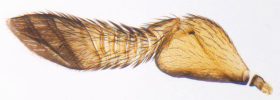 Fig. 1. Antenna Fig. 1. Antenna
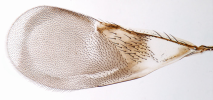 Fig. 2. Fore wing venation Fig. 2. Fore wing venation
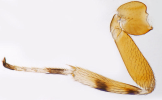 Fig. 3. Hind leg Fig. 3. Hind legImages
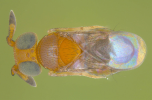
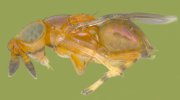 Adult female, dorsal and lateral view
Adult female, dorsal and lateral view
Distribution
India: ?Assam, Kerala, Karnataka, Maharashtra, Tamil Nadu, Uttar Pradesh (Hayat, 2006).
Hosts / Biology
Drepanococcus (=Ceroplastodes) spp., D. cajani (=Ceroplastodes
cajani), D. chiton, Parasaissetia nigra, Pulvinaria maxima, etc. on various hosts (Hayat, 2006).
References
- Hayat, M. 2006. Indian Encyrtidae (Hymenoptera: Chalcidoidea). Department of Zoology, Aligarh Muslim University, Aligarh. vii+496 p.
- Mani, M.S. 1935. A new encyrtid chalcid genus, Krishnieriella gen. nov., from India. Records of the Indian Museum, 37: 421-423.
|